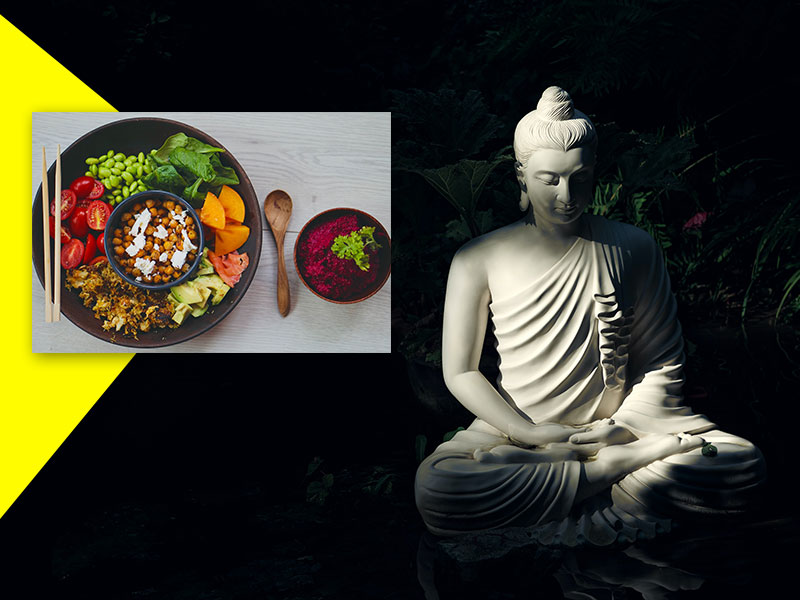
Like every other religion, Buddhism also has certain food practices and rules. Siddhartha Gautama, or the Buddha, founder of Buddhism, made it a rule for his followers, or the Buddhist monks, to eat from dawn till noon and abstain for the rest of the day. Hence, long before intermittent fasting became a fad, Buddha preached it to his followers for good health, sound mind and quality life. Writer and Zen follower Dan Zigmond in his 2016 book ‘Buddha’s Diet: The Ancient Art of Losing Weight Without Losing Your Mind’ combined Buddhist eating with modern science to give us the Buddha’s diet.
Table of Content:-
What is Buddha’s diet?

(Photo Credit: Freepik)
Just like the time-restricted eating preached by the Buddha, Buddha’s diet propagates the same. However, you don’t have to eat from dawn till noon and starve for the rest of the day. Starting from eating in a 13-hour window, the idea is to gradually reduce it to 9 hours. The good news: you can eat whatever you like as long as you eat in that 9-hour window. Hence, ‘when’ you eat is the key in Buddha’s diet rather than ‘what’ and ‘how much’ like in other diets. And why not? Your digestive system and metabolism, unlike the heart and the lungs, weren’t designed to run nonstop and need that break just like you.
How to practise Buddha’s diet?
Start eating in a 13-hour window for the first two weeks, which is harder than it sounds. Just think about your late-night craving indulgences and all that going out with friends. Then, gradually restrict it to 12 hours, then 11, 10 and finally 9, which is your ultimate goal. So you can have breakfast at 9 am and dinner at 6 pm and nothing after that. You can set the time as per your schedule. So, just like Buddha preached a middle path, Buddha’s diet preaches the same in a way -- between the do not eat after noon norm and eat whatever you like, at whatever time you want.
Also read: 9 Reasons Why Sprouts Should Be A Part Of Your Diet
Buddha’s diet: Some specifications

(Photo Credit: Unsplash)
Now that you know the gist of this diet, here are some specifications you need to know:
- Eat whatever you want: Most modern diets are highly restrictive in the way that they limit our food options, especially those we love and over time make us miserable. Hence, these are unsustainable. Buddha’s diet makes no such restrictions, other than the ‘when’ part. The idea of Buddha’s diet is not what you should eat and what you should not, but what is good for you (fruits, vegetables, whole grains) and what is not (sugar, packaged foods). And it is you who has to make this choice.
- Mindfulness: This gets us to the next step. Mindfulness is a major tenet in Buddhism. The same is the case with Buddha’s diet. Pay attention to what you are eating, why and its impact to your body. We all know the concept of emotional and stress eating. Pay attention on these and you’ll easily cut yourself some calories. Similar is the case with what you eat. Once you focus on that and its impact on your body, you’ll be able to make better food choices.
- Have a cheat day, once in a while: Buddha’s diet allows you to have a cheat day once every week. And on that day you can eat outside your eating window. This helps you reset and refuels you to stick to your diet.
- What about exercise? Zigmond says exercise doesn’t help you burn as many calories as it seems. Also, it leaves you hungry. So, Buddha’s diet doesn’t make it compulsory for you to work out. However, who can refute its benefits? It keeps your body fit and your mind agile. Zigmond recommends exercising first thing in the morning and if possible, on an empty stomach, as it helps you to lose fat quicker.
- Clean your plate? As kids, who haven’t heard their parents nagging about us leaving food on our plates. From how much effort was put into preparing that meal to food scarcity in some part of the world, we’ve heard it all. However, Zigmond argues the opposite. Once you are full, would that food be better in the trash or in your body? Rephrase: Should you throw that extra food in the trash or use your body as one? The idea isn’t to throw food away, but to be more conscious and cautious about how much you eat and how much you need. This will solve your trash conundrum.
Also read: Can Very Low Calorie Diet Aid Weight Loss? Expert Answers
So, follow these tips and you’ll not only see the scale going down but your relationship with food will change. Just pay attention to the several aspects of food and make choices accordingly. To know more about Buddha’s diet, read Dan Zigmond’s book ‘Buddha’s Diet: The Ancient Art of Losing Weight Without Losing Your Mind’.
Read more articles on Weight Management
Photo Credit: Unsplash
Also watch this video
How we keep this article up to date:
We work with experts and keep a close eye on the latest in health and wellness. Whenever there is a new research or helpful information, we update our articles with accurate and useful advice.
Current Version